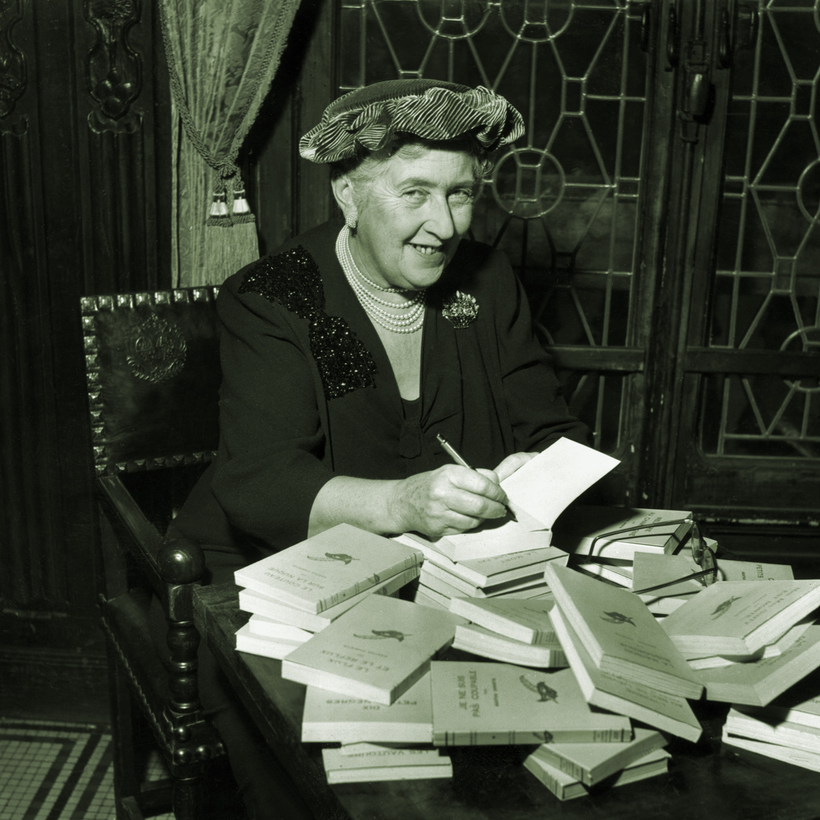At first I was put off by the scary illustrations in Kathryn Harkup’s new book, V Is for Venom: Agatha Christie’s Chemicals of Death. My fears weren’t roused by pictures of grotesque corpses or ominous crime scenes, but by diagrams of molecules and chemical reactions horribly reminiscent of my dreaded high-school chemistry textbook.
Indeed, images of atoms balanced in Calder-esque designs are the only illustrations in the book. Fortunately, I resisted the temptation to abandon it, and I came away with an understanding of chemical interactions, and particularly of the nonstop frenzy of biochemical activity that keeps us alive, clearer than I ever gained from school.
Of course, keeping the body alive is just what Agatha Christie and her killers don’t want to do. Poison was their preferred means of murder, featuring in more than 80 of her mysteries. It’s not surprising. Christie was an expert in toxicology, with knowledge and experience gained as a pharmacy dispenser during both World Wars. Also, while bullets, blades, and blunt objects can do the job, they lack the subtlety of poison, the challenge of obtaining and administering it for the murderer and of sorting out symptoms, substances, and suspects for the detective. Poison also allows for an abundance of clues and red herrings to scatter for the reader.
The book is a sequel to Harkup’s 2015 success, A Is for Arsenic. Here, her deadly alphabet soup includes toxins ranging from arrow poison and bacteria to nitroglycerin and snake venom. In simple, straightforward prose she describes each poison on a molecular level and its deadly effects on human biochemistry.
Then she tosses her microscope aside and digs into the murder at hand. She sets Christie’s scene and introduces the cast of victims and suspects, following up with some intriguing questions. What’s the history of the particular poison? How could the murderer obtain and administer it? Has it been used in any real-life cases? Is there an antidote? The answers are frequently fascinating.
In the prehistoric wild, humans found natural toxins, such as the African arrow poison Kombé, which hunters extracted from local vines. Christie and three of her murderers used the modern formulation of Kombé, strophanthin. Some toxins find us, like the bacteria that cause anthrax and typhus. Christie makes use of both.
Most poisons were discovered in laboratories after painstaking—and sometimes painful—research. In 1884, while searching for an anesthetic, a German scientist treated his own eye with cocaine, testing its efficacy by sticking pins in his eyeball. Some tweaking of the cocaine molecule produced procaine. (We call it novocaine.) A Christie villain dispatched his victim with a lethal dose of it in a dentist’s chair.
As a young medical student, Arthur Conan Doyle dosed himself with dangerous amounts of gelsemine, the poison found in yellow jasmine, while trying to determine when the drug reached toxicity. Luckily, the increasingly unpleasant symptoms overwhelmed him. He stopped his experiments and lived to tell some tales. One of Christie’s characters was not so lucky.
Obtaining poisons became more difficult for her murderers over the years Christie was writing. In the 1920s and 1930s, strychnine, arsenic, and coniine (hemlock poison) filled the shelves of every pharmacy. Over time, safer substitutes were found and regulations were tightened. Authors and their murderers had to become more ingenious. The would-be killer in The Lemesurier Inheritance had to boil masses of black ants and distill them just to get enough formic acid for a lethal injection.
Once he had a supply of his chosen toxin, how was a murderer to administer the lethal dose? It was usually delivered in the form of a drink or an injection. (Since more of Christie’s villains were doctors than any other profession, syringes roused no suspicions.) She did, nonetheless, dream up some novel means, particularly when the poison was bacterial. In Cards on the Table, the killer cultures his own deadly stash of anthrax spores and sprinkles them on his victim’s shaving brush. The tiniest razor nick does the rest.
Christie liked a nice, tidy crime scene; even her most violent murders never ended in bloody messes, with the spatter of gore and brain matter so beloved by today’s writers. However, she once deployed bacteria as a murder weapon in a way that makes the gorge rise. The victim’s lacerated hand is wrapped in a bandage that has been carefully spread with pus from a cat’s infected ear. Beneath that pristine-looking white gauze, bacterial hell breaks loose. Blood poisoning and death soon follow.
Harkup’s book overflows with clear science, intriguing crimes both fictional and real, many warnings to aspiring murderers of the “Don’t try this at home!” variety, and lots of interesting details about Christie’s life in crime. She passes along Christie’s most cherished compliment, from a review in The Pharmaceutical Journal: “This novel has the rare merit of being written correctly.” V Is for Venom is all that, and most entertaining to boot.
Robin Olson is a writer and painter

